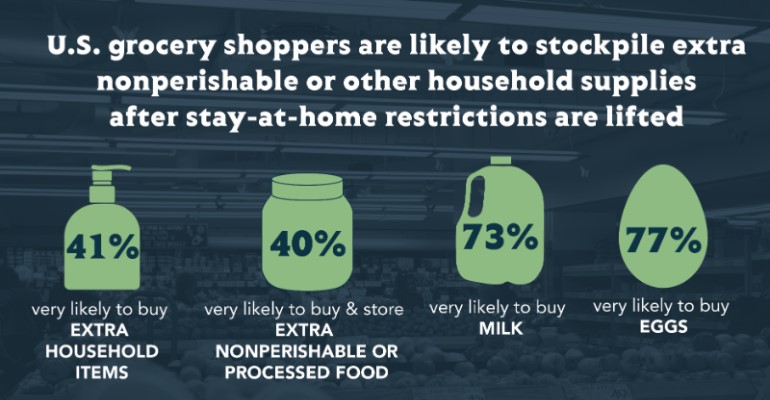Health, safety top concerns for shopping, dining
Clearly defined protocols needed when restaurants reopen and grocery shopping returns to normal.
May 1, 2020

Health and safety will remain a top concern for consumers once stay-at-home restrictions are lifted, according to new research released by Inspire PR Group and full-service market research firm Illuminology. The vast majority of those surveyed want grocery stores and restaurants to have employees wear face masks and encourage social distancing. However, when presented with all safety options, shoppers and diners said they are most concerned about the perceived health threat posed by other customers, more so than employees.
The results of the nationwide survey, "Eating 2020: How COVID-19 Will Change Consumer Engagement with Food," gauged the food purchasing trends of more than 1,800 U.S. consumers before, during and after the COVID-19 stay-at-home restrictions.
“These findings contribute data to what we’ve believed to be true: that both restaurants and groceries should prepare to meet consumer expectations for health and safety for some time to come,” Inspire PR Group president Hinda Mitchell said. “Clearly defined protocols around how these businesses will keep their customers safe – mostly from other customers – will be critical to restoring trust and confidence.”
Grocery shopping insight
Although grocery chains saw a surge of new customers for online pickup and delivery orders in April 2020, these platforms are likely to see significant declines back to pre-COVID-19 levels or lower after stay-at-home restrictions are lifted. The survey found that of the recently acquired customers, more than one-third are unlikely to use online pickup and nearly half are unlikely to use online delivery when restrictions are lifted.
Stockpiling extra non-perishable foods and household supplies is likely to continue, with four in 10 respondents saying they are very likely to buy and store these items after stay-at-home restrictions are lifted.
After restrictions are lifted, 73% said they are very likely to buy milk, and 77% are very likely to buy eggs.
Consumers are fearful of other shoppers making them ill. Approximately 23% of shoppers most prefer that customers wear face masks, and 18% prefer limiting the number of customers allowed in the store.
Dining in to return, but slowly
Consumers who dined in at restaurants before the pandemic are likely to return when restaurant-specific orders are lifted – and that’s good news for U.S. restaurants. However, projections suggest that there could be a 20% difference in dine-in traffic from pre-COVID-19 levels. Also, restaurants that focus more on quality dine-in experiences (e.g., upscale, local/neighborhood and fast-casual restaurants) are more likely to return to pre-COVID-19 customer levels.
The survey found that 37% of diners are extremely or very worried about getting sick from other customers if they eat a meal inside a restaurant. While carryout, drive-thru and food delivery nearly doubled from once every two weeks to once per week, the frequency of these services is projected to decrease significantly after stay-at-home restrictions are lifted.
Most sectors are projected to see a return to pre-COVID-19 levels of visits. Although dine-in visits will increase, they will not return to pre-stay-at-home levels. The survey found that 45% of people will dine inside a restaurant soon after COVID-19 restrictions are lifted, versus 67% who did so pre-COVID-19 restrictions.
Restaurant spending is a concern, with more than 60% feeling like they could not pay or would worry about paying $75 for a family dinner out, suggesting that the pandemic’s economic toll is having a continued impact on this sector.
“Overall, these data tell a story of consumers’ changing purchase patterns before, during and after an incredible shock to our economic and health systems,” Illuminology chief executive officer Orie Kristel said. “Groceries and restaurants need to be especially cautious when planning their operations after COVID-19 stay-at-home restrictions are lifted. Although many customers likely crave a great dining or shopping experience, many customers are also concerned about potential monetary or health issues.”
Methodology
The research, conducted April 17-20, 2020, surveyed 1,300 U.S. consumers and an additional sample of 500 Ohio consumers. The survey asked respondents about their grocery and restaurant behaviors in the first two months of 2020 before COVID-19 became a crisis in the U.S., behaviors during stay-at-home orders in April and how they anticipate their behaviors to change in the first 60 days after orders are lifted.
The research also sampled more than 500 respondents in Ohio because it was among the first wave of states to adopt stay-at-home measures and has seen a “flattening” of the case curve. Under the leadership of Gov. Mike DeWine, Ohio has been notably aggressive in its response to COVID-19, and the state mounted a broad public information campaign to educate residents.
Although consumer behaviors in Ohio versus the national research had many similarities, one significant finding is that those in Ohio were statistically less likely to be extremely or very worried about getting sick from COVID-19 compared to the nation as a whole: 33% versus 41%, respectively.
You May Also Like



